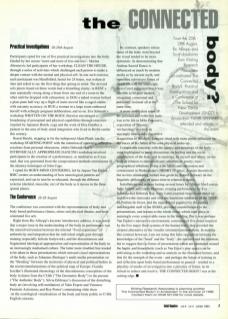Practical Investigations 20-26 August
Participants opted for one of five practical investigations into the body. Guided by her axiom ‘more and more of less and less’, Marina Abramovic led participants of her workshop Clean the House through a series of activities which challenged each person to make a deeper contact with the mental and physical self. In one such exercise, each participant was blindfolded, fasted for 24 hours, was woken at 4am, and asked to say the first thing that sprung to mind. The devised solo pieces based on these words had a disturbing clarity: in Rest a man repeatedly swung along a beam from one end of a room to the other until he dropped with exhaustion; in Dog a naked woman behind a glass pane half way up a flight of stairs moved like a caged canine with uncanny accuracy; in Hug a woman in a large room embraced herself with achingly poignant deliberation, and so on. Eva Schmale's workshop Written on the Body likewise encouraged a broadening of perceptual and physical capabilities through exercises inspired by Japanese Butoh, yoga and the work of Elsa Gindler, a pioneer in the area of body-mind integration who lived in Berlin earlier this century.
Ronal Burchi, stepping in for the indisposed Alain Platel, ran the workshop Starting Point with the intention of spawning collective creations from personal obsessions, whilst Deborah Hay's Intrinsically Appropriate Dancing workshop involved participants in the creation of a performance, as meditative as it was mad, that was generated from the compositional methods reminiscent of the aleatory techniques of John Cage.
I opted for Body-mind Centering, led by Jaques Van Eijden. BMC creates an understanding of how neurological patterns are expressed, and can in turn be re-educated, through the different systems (skeletal, muscular, etc) of the body as it moves in the three spatial planes.
The Conference 26-28 August
The conference was concerned with the representations of body and body-based performance (dance, mime and physical theatre, and body-orientated live art).
Right from Ric Allsopp's keynote introductory address, it was noted that a major issue in the understanding of the body in performance was the unresolved tension between the internal ‘lived experience’ of authenticity and integration that the individual might gain through training (especially holistic bodywork), and the discontinuous and fragmented ideological appropriation and representation of the body in an increasingly mediatised culture. The latter more troubled line tended to be taken in those presentations which stressed visual representations of the body, such as Johannes Birringer's multimedia presentation on the ‘bleeding’ between the territories of physical and political bodies in the recent transformations of the political map of Europe; Claudia Jeschke's illustrated chronology of the discontinuous conceptions of the body in dance from the 16th Century (‘The Geometric Body’) to the present (‘The Authentic Body’); Silvia Eiblmayr's discussion of the disturbing body art (involving self-mutilation) of Valie Export and Viennese Feminist Actionism; and Roy Porter's entertaining slide show on the scatological visualisations of the body and body politic in 18th Century English cartoons.
By contrast, speakers whose sense of the body went beyond the visual tended to be more optimistic. In demonstrating that Andean Sacred Dance is influenced as much by modern media as by ancient myth, and enmeshes subversive forms of social life with the landscape, Enzo Cozzi suggested that it was possible to be post-modern, integrated, communal and politically resistant all at the same time.
A more ambivalent sense of the personal and collective body was to be felt in Mike Pearson's exposition of Theatre Archaeology in which he movingly interlaced a discursive disquisition of Neolithic funerary ritual with more poetic reflection on the traces of his father in his own physical make-up.
Comparable concerns with the agency and meanings of the body were highlighted in panel discussions on healing and the social construction of the body, and in seminars, by myself and others, on the body in relation to alternation and substitution, poetry, transgeographical tribalism, living with AIDS, and subversion and containment in Shakespeare's Henry IV plays. A more theoretical but no less stimulating lecture was given by Robert Schwarz on the linguistic philosophy of space-time in relation to dance.
Installations and actions lasting several hours by Alistair MacLennan, Sally Tallent and Linda Montano, evening performances by Eva Schmale and Deborah Hay, witty Latin-inspired improvised dance up and down the staircases and over the lunchtime table tops of the SNDD by Pauline de Groot, and the superb food supplied by the equally indefatigable staff of the SNDD, provided counterbalance to the presentations, and texture to the whole event, which took place in seemingly every conceivable room in the building. But it was perhaps Van Eijden's interactive environment, consisting of five zones inspired by the five major fluid systems of the human body, that provided the clearest alternative to the visually orientated presentations. In making this contrast, however, I am not using that false opposition between the knowledges of the ‘head’ and the ‘body’, the intellect and the intuition, but to suggest that (a) forms of presentation which are orientated around the haptic and kinaesthetic (such as Van Eijen's play space) can be as enlivening as the workshop and as analytic as the illustrated lecture, and that (b) the strength of the event and perhaps the future of training in and reflection upon body-based performance in general – resided in a plurality of modes of investigation into a plurality of forms. In its refusal to reduce and resolve, The Connected Body? was at the cutting edge.
Writing Research Associates is planning another The Connected Body? in Amsterdam in the summer of 1996.

